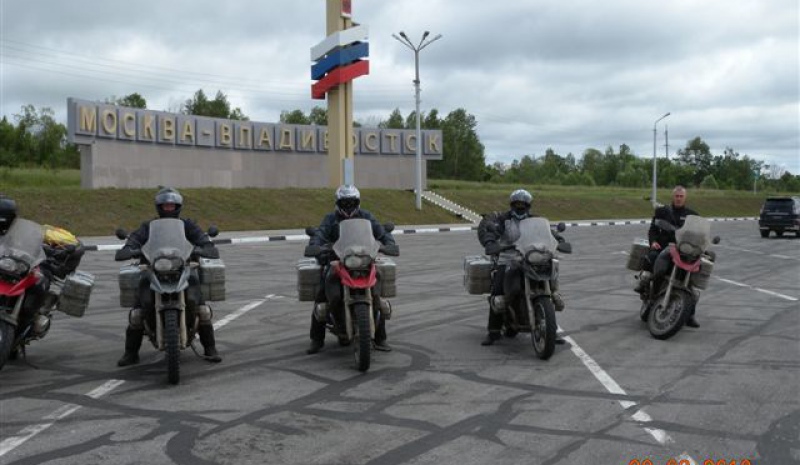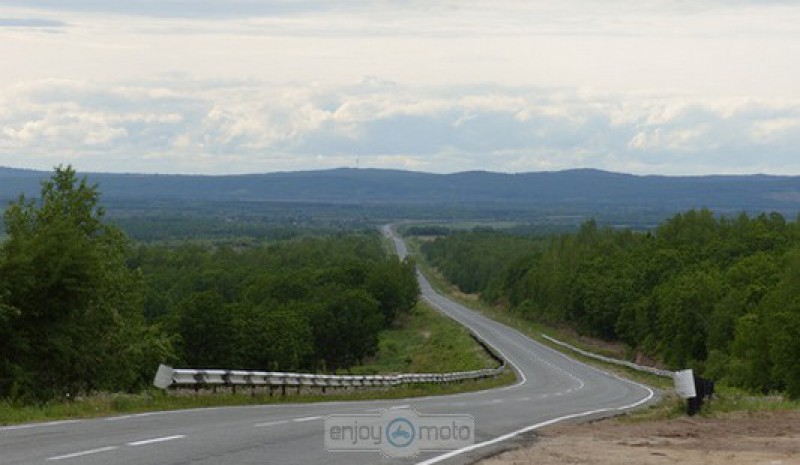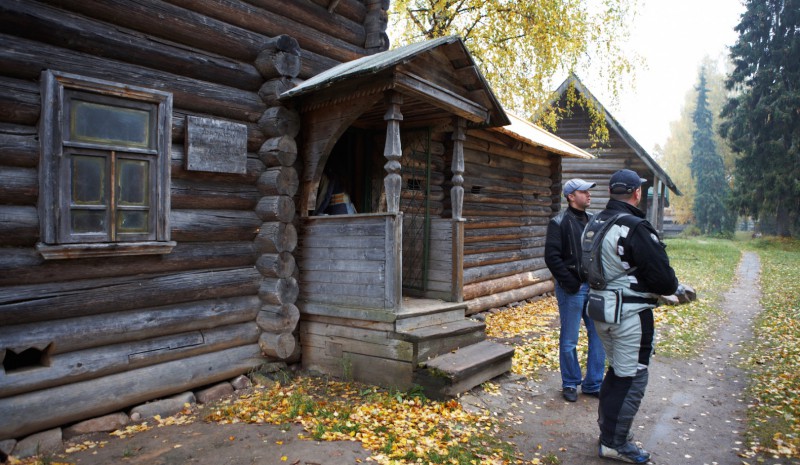Through Russia from Moscow to Vladivostok
Video

Route
Description
Highlights
Tour description
Day 1. Moscow arrival
First day you come to the Capital of Russia – Moscow! We meet you at the airport and bring to the hotel. Day is for leisure. In the evening we meet all together for welcome dinner.
Day 2. Moscow, motorcycle pick up
In the morning – Moscow city tour by bus with English speaking guide. In the afternoon we gather for briefing and motorcycle pick up.
Day 3. Moscow – Nizhniy Novgorod, 540 km
Start early in the morning. We avoid busy highway and ride a small road through the countryside. Stop for a lunch in Suzdal and come to Nizhniy Novgorod in the evening. We walk around the city, have nice dinner and have a rest.
Although some authorities give an earlier date, the city was founded, according to a major chronicle, in 1221 by Yury Vsevolodovich, prince of Vladimir, as Russian colonization was advancing to the Volga into lands formerly occupied by the Mordvinians. In 1392 the town was incorporated into the principality of Moscow and soon became a Russian stronghold against the Volga Tatars. The Russian conquest of the Volga in the mid-16th century brought about increased trade for Nizhny Novgorod. The annual fair that was established in that city in 1817 became the largest and most important in Russia, attracting traders and goods from across Europe and Asia. The fair continued until the Russian Revolution of 1917. The well-known writer Maxim Gorky was born in Nizhny Novgorod in 1868, and in 1932 the town was renamed in his honour by the Soviet regime, although its original name was restored in 1990.
Day 4. Nizhniy Novgorod – Kazan, 490 km
Today we ride towards Kazan – the Capital of Tatar Republic.
Ancient Kazan was founded in the late 13th century by the Mongols (Tatars) of the Golden Horde after their overthrow of the Bulgar kingdom on the middle Volga. After the disintegration of the Golden Horde in the 15th century, Kazan became the capital of an independent khanate. It developed as an important trading centre; annual fairs were held on an island in the Volga. In 16th century the old Tatar fortress was rebuilt as a Russian kremlin, the white walls and towers of which survive as a feature of the modern skyline. Kazan was seized in a revolt of 1773–74, and much of the city was burned to the ground; Catherine II the Great rebuilt it on a gridiron pattern. As Siberia was opened up, Kazan’s trading importance greatly increased, and industry developed in the 18th century; by 1900 it was one of the chief manufacturing cities of Russia. Kazan is a major cultural and educational centre. Kazan State University was founded in 1804. The mathematician N.I. Lobachevsky was its rector in 1827–46, and among those who studied there were Leo Tolstoy, the composer M.A. Balakirev, and Vladimir I. Lenin.
Day 5. Kazan. Rest day
Kazan is so beautiful nowadays that we stay here a day to explore and enjoy its beauty. Tatar cuisine is different from Russian, and of course we try most delicious food!
Day 6. Kazan – Izhevsk, 400 km
Riding northern-west to Izhevsk, the motherland of world-famous Kalashnikov. We have enough time to visit museum and do some shooting.
Izhevsk is the capital city of western Russia’s Udmurt Republic. It’s known for the Kalashnikov Museum and Exhibition Complex of Small Arms, which displays weapons and documents the Russian arms trade.
Day 7. Izhevsk — Yangantau, 550 km
We are crossing Ural mountains and entering Republic of Bashkiriya (Bashkortostan), another landscape, another traditions, another cuisine.
Ural Mountains, also called the Urals, Russian Uralskie Gory or Ural, mountain range forming a rugged spine in west-central Russia and the major part of the traditional physiographic boundary between Europe and Asia. Extending some 1,550 miles (2,500 km) from the bend of the Ural River in the south to the low, severely eroded Pay-Khoy Ridge, which forms a 250-mile (400-km) fingerlike extension to the northern tip of the Urals proper, the mountains constitute the major portion of the Uralian orogenic belt, which stretches 2,175 miles (3,500 km) from the Aral Sea to the northernmost tip of Novaya Zemlya.
Day 8. Yangantau — Ekaterinburg, 340 km
Through the Lake Region we ride to Yekaterinburg. The distance is small, so in the afternoon we will have opportunity to see the city.
Near the village of Shartash, which was founded in 1672 by members of the Russian sect of Old Believers, an ironworks was established in 1721 and a fortress in 1722. In 1723 the new settlement was named Yekaterinburg in honour of Catherine I, the wife of Peter I the Great. The town grew as the administrative centre for all the ironworks of the Urals region, and its importance increased after 1783, when the Great Siberian Highway was built through it. After 1878 the Trans-Siberian Railroad linked the city with Siberia.
Modern Yekaterinburg is one of the major industrial centres of Russia, especially for heavy engineering. The Uralmash produces heavy machinery and is the city’s largest enterprise; it once employed some 50,000 workers, though it now has a small fraction of that number. Engineering products manufactured in the city include metallurgical and chemical machinery, turbines, diesels, and ball bearings. Boris Yeltsin, the first democratically elected president of Russia, was educated and spent much of his political career in the city.
Day 9. Ekaterinburg — Tyumen, 380 km
The main attraction of the days is the factory Irbit, which produce world famous Ural motorcycles. We spend some time there, entering Western Siberia we ride to the “Oil Capital of Russia” – Tyumen.
Ural was originally founded in 1941, tasked with building sidecar motorcycles to help aid the military in WWII. After the war ended, motorcyclists fell in love with the practicality of our sidecars and their off-road capabilities. The main products today are the heavy duty Ural sidecar motorcycles with two-wheel-drive designed for rough, rugged terrain, and cT model for urban commuting and paved road touring.
Day 10. Tyumen — Omsk, 630 km
Today we ride strait road to Omsk, not so many things to explore on a way. Omsk is famous as a motherland of EnjoyMoto co-owner (joke). But, seriously, it’s a city with history, there are some places to see. That we will do, upon arrival.
Day 11. Omsk — Novosibirsk, 650 km
Long day to Novosibirsk – chief city of western Siberia.
Novosibirsk (New Siberia) was developed on the left bank as the crossing point of the Ob river for the Trans-Siberian Railroad in 1893. The settlement was known variously as Gusevka, but in 1895 it was renamed Novonikolayevsk in honour of the accession of Tsar Nicholas II. The bridge was completed in 1897, and in 1903 town status was conferred.
Novosibirsk is a major manufacturing centre. The city also has a large tin smelter and a highly specialized gold refinery. Engineering works produce heavy machinery, military aircraft, hydraulic presses, electrothermal equipment, ore-concentrating and mining machinery, and agricultural machinery. The university of the city and a number of institutes are located in the satellite town of Akademgorodok (Academic Town). From the 1960s Akademgorodok has comprised Russia’s largest cluster of basic science research institutes and personnel outside Moscow and St. Petersburg.
Day 12. Novosibirsk — Tomsk 300, km
“Short ride” to Tomsk to have some rest in the afternoon. Tomsk is cosy wooden Siberian town. It considers to be the oldest town in Siberia, more then 400 years.
Day 13. Tomsk – Krasnoyarsk, 580 km
Today we have 4000 km behind. Big deal, isn’t it? You’ve seen a lot, but prepare for more impressions! Now we are in Eastern Siberia, riding to Krasnoyarsk. We stay here for 2 nights, to have rest and to visit a national park.
Krasnoyarsk was founded by the Cossacks headed by Andrey Dubensky in 1628 as a military settlement in the place of the confluence of the Kacha and Yenisei rivers. Originally the settlement was called “Krasny Yar”. Krasnoyarsk became a town in 1690, when Siberia was finally annexed to Russia. Krasnoyarsk lies along Enisey river — one of the most beautiful and powerful rivers of Siberia. It is surrounded by mountains, giving a very interesting flavour to the city views.
Day 14. Krasnoyarsk. Rest Day.
No riding today. You can enjoy drinking beer in a bus, which bring you to the National Park Stolby and to Hydroelectric power station.
Stolby Nature Sanctuary is a Russian strict ecological reserve located 10 km south of the city of Krasnoyarsk, on the north-western spurs of the Eastern Sayan Mountains. The site is known for its dramatic complexes of rocks; 3.5% of the reserve is open to hikers seeking to visit and climb the rocks.
Day 15. Krasnoyarsk – Toulun, 680 km
Long ride through Siberia. About 5000 km and you are still in Russia, same language, different landscapes, people are similar and different in a same time. Now you know a lot about Russia, but still a lot to explore. We overnight in a small Siberian town.
Day 16. Toulun - Baykal lake, 390 km
Great day, “short ride” to the biggest lake in a World – Baykal! We stay there for 3 nights and have enough time to have a good rest and enjoy the nature. We go fishing, swimming, boating and relax.
Day 17. Baykal Lake
Day 18. Baykal Lake
Day 19. Baykal Lake – Ulan-Ude, 460 km
Good bye Baykal, we are going east to the Capital of Buryatia Republic.
Ulan-Ude is the first city along the way to the east that feels like you’ve finally arrived to Asia. It is a very unusual and charming city. The first striking impression is an unusually calm and mellow way of life, distinct features of people (more than 50% of people in Ulan-Ude are native Buryats with canny almond eyes), and a slightly chaotic look of the city. Ulan-Ude is a centre of Buddhism in Russia. However, in some parts of Ulan Ude the “Russian part” comes into play: a huge head of Lenin on the central square, Soviet style hotel buildings, some remains of the typical 19th century architecture, traditional wooden houses along the streets. And at the same time little Korean passenger minibuses are rushing back and forth, like rickshaws, an old Buryat woman is selling hot juicy Pozas (traditional meat dish) on the street, the sun is unbelievably bright and hot, and you see the tips of the mountains surrounding the city…
Day 20. Ulan–Ude – Chita, 660 km
Going east… Next destination is Chita.
But, of all Eastern Siberia’s major cities, Chita is the least prepared for visitors. It was literally put on the map by the noble-blooded Decembrists, one of whom designed its street-grid layout. Today there’s nothing aristocratic about this regional capital where Soviet symbols still embellish Stalinist facades and Chinese cross-border peddlers lug monster bales past a well-tended Lenin statue…
Day 21. Chita – Erofey Pavlovich, 760 km
Today you feel the meaning of “to be in the middle of nowhere”, but we are close to the aim!
Day 22. Erofey Pavlovich - Blagoveshchensk , 790 km
Riding along the Chinese border we arrive to Blagoveshchensk. We are so close to China, that you can see the lights of Chinese cities.
In 1644, the first Russian settlers moved to the area and founded their settlement. Russian military outpost was founded later in 1856. The town received its name “Blagoveshchensk” after the parish church of Annunciation (Blagoveshcheniye in Russian). By the end of the 19th century, the town was a large river port and industrial center. Also, it was growing fast because of gold rush. Blagoveshchensk had favorable position, situated on the Chinese-Russian border (about hundreds of meters opposite the city of Heihe). Blagoveshchensk is one of the oldest merchant cities of the Russian Far East. Today, it acts as an intermediary in trade and industrial links of Siberia and the Far East with China.
Day 23. Blagoveshchensk – Khabarovsk, 690 km
Last, but not least stop before we arrive to Vladivostok! Riding all day along Chinese border though taiga.
Khabarovsk lies along the Amur River just below its confluence with the Ussuri. The town was named after the Russian explorer E.P. Khabarov, who made several expeditions to the Amur River basin in the mid-17th century. The modern city was founded in 1858 as a military outpost. Its nodal position at the point at which the Trans-Siberian Railroad crosses the Amur made it an important focus of the Russian Far East, and at one time it administered the entire area to the Bering Strait. Modern Khabarovsk spreads across a series of small valleys and ridges perpendicular to the Amur. The city has an attractive waterfront park and esplanade and a mixture of modern apartment blocks, factories, and old, one-story wooden houses.
Day 24. Khabarovsk — Vladivostok, 770 km
Riding through Ussuri taiga to our final destination – Vladivostok! Upon arrival, we drop off the bikes and say them good-bye.
Vladivostok, seaport and administrative centre of Primorsky. It is located around Zolotoy Rog (“Golden Horn Bay”) on the western side of a peninsula that separates Amur and Ussuri bays on the Sea of Japan. The town was founded in 1860 as a Russian military outpost and was named Vladivostok. Its forward position in the extreme south of the Russian Far East inevitably led to a major role as a port and naval base.
Day 25. Vladivostok
Day for relax and explore. After a good sleep, we see the city and try delicious seafood for Farewell dinner.
Day 26. Vladivostok – departure
Today we say goodbye and leave Russia.
There is a possibility to start the tour in Saint-Petersburg upon request, it takes 4 days more before the official tour starts.
What's Included
- Motorcycle one way rental
- Fuel
- Accommodation 3* (there are some places with very basic stay)
- Return airticket Vladivostok — Moscow (economy class, business extra 1050 euro)
- Transfers airport — hotel — airport
- All breakfasts, water and snacks
- Dinners in Moscow and Vladivistok
- Professional tour guide
- Support car
- Professional mechanic
- Excursions and entrance tickets
- Souvenir from the company
- Personal care and assistance
What is not included
- Airtickets to Russia
- Food and drinks not mentioned above
- Medical insurance — compulsory
- Travel insurance — recommended
- Tips
- Everything that is not mentioned above
Price
- BMW G650GS — 7760 euro
- BMW F800GS — 8620 euro
- BMW R1200GS — 9050 euro
- Ural Gear Up — 8620 euro
- Single room supplement 3* — 350 euro
- 5* accomodation supplement — 650 euro
- Single room supplement 5* — 1020 euro














Comments (0)
Write comment